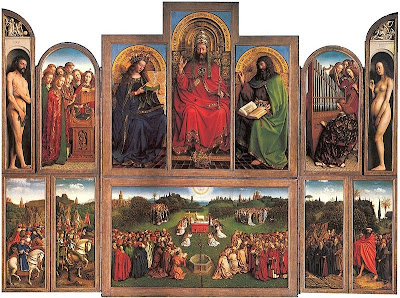Since the Bible is a compilation of 66 books by 40 authors, it is a lot of things, including an historical record. It includes rather ugly facts about the condition of women in the ancient world. That doesn’t make it misogynistic; it makes it history. It’s also replete with women heroes.
For some reason, the history of Renaissance art includes a great love for the two warrior women, Judith and Jael. I’ve been thinking a lot about these paintings since my visit to the Met last weekend. Why is it that the predominantly male art world was so fascinated by the hammer of retribution being wielded by the feminine hand?
The story of Jael comes from the Book of Judges. Deborah, the only named female prophet and judge in the Bible, advised Barak to mobilize troops to meet a Canaanite threat. Barak whined. Deborah agreed to go with him, but told him that the honor of victory will go to a woman because he was being such a wimp. A downpour mired the Canaanite chariots and they were defeated. Their general, Sisera, fled on foot to the tent of Jael, wife of Heber the Kenite. She gave him a jug of milk and a blanket and he fell asleep. While he was sleeping, Jael drove a tent peg through his skull.
The story of the beheading of Holofernes by Judith comes from a book we now consider deuterocanonical, although it was part of the Catholic Bible during the Renaissance. Judith visited the tent of the Assyrian general Holofernes, who was about to trash Judith’s hometown. Drunk, he passed out. Judith sawed his head off, and it was carried away in a basket.
The story of Susanna and the Elders is considered doctrinal by Catholics and Orthodox Christians and apocryphal by Protestants. As Susanna bathed in her garden, she was watched by two voyeurs, who, as elders, were powerful. They threatened to accuse her of meeting her lover in the garden unless she agreed to sleep with them. Refusing to be blackmailed, she was about to be put to death when young Daniel insisted on a proper investigation. The elders’ stories didn’t match, and Susanna’s virtue escapes unscathed.
These subjects are considered part of a medieval and Renaissance art genre which inverts the typical power relationship between men and women. They included myriad secular stories and classical myths as well as the Bible stories I’ve mentioned. What they reflect are the gender politics of the late middle ages, not those of the Biblical era.
I’ve used paintings of these subjects by Artemisia Gentileschi. She was almost alone in being a successful woman Renaissance painter. She has a unique view of the Power of Women discussion.
There is another hero woman mentioned in Samuel who didn’t get much traction with painters. Abigail overrode her loutish ingrate husband to intervene with an irate King David. She has been painted at her meeting with David, when she prophesizes his greatness and begs him to spare her people, saying that in his moment of greatness, “ my lord will not have on his conscience the staggering burden of needless bloodshed or of having avenged himself.”
The part I would like to paint, however, is when she went home to Nabal and told him off for being such an ass. He had a hangover, and then he had a stroke, and then he died. A fine ending, that.







































